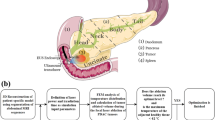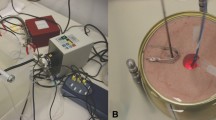Abstract
Tissue temperature distribution plays a crucial role in the outcome of laser-induced thermotherapy (LITT), a technique employed for neoplasias removal. Since recent studies proposed LITT for pancreatic tumors treatment, assessment of temperature and of its effects around the laser applicator could be useful to define optimal laser settings. The aims of this work are temperature monitoring and measurement of ablated tissue volume in an ex vivo porcine pancreas undergoing double-applicator LITT. A three-dimensional numerical model is implemented to predict temperature rise and volumes of ablated tissue in treated pancreas. Experiments are performed to validate the model, with two modalities: (1) 12-fiber Bragg grating sensors are adopted to monitor the heating and cooling during LITT at several distances from the applicators tip, and (2) 1.5-T MR imaging is used to estimate the ablated volume. Experimental data agree with theoretical ones: at 2 mm from both applicators tips, the maximum temperature increase is approximately 60 °C downward from the tips, while it increases of about 40 °C and 30 °C, respectively, at the level and upward from the tips. This behavior occurs also at other distances, proving that the tissue downward from the tip is mostly heated. Furthermore, the estimated volume with MRI agrees with theoretical one (i.d., 0.91 ± 0.09 vs. 0.95 cm3). The encouraging results indicate that the model could be a suitable tool to choose the optimal laser settings, in order to control the volume of ablated tissue.





Similar content being viewed by others
References
Vogl TJ, Müller P, Weinhold N, Hummerstingl R, Mack MG, Böttcher H, Philipp C, Felix R (1995) MR-guided laser-induced thermotherapy (LITT) of liver metastases. In: Müller G, Roggan A (eds) Laser-induced interstitial thermotherapy. SPIE–The International Society for Optical Engineering, Washington
Whelan WM, Wyman DR (1999) Dynamic modeling of interstitial laser photocoagulation: implications for lesion formation in liver in vivo. Laser Surg Med 24:202–208
Saccomandi P, Schena E, Di Matteo FM, Pandolfi M, Martino M, Rea R, Silvestri S (2011) Laser interstitial thermotherapy for pancreatic tumor ablation: theoretical model and experimental validation. Conf Proc IEEE Eng Med Biol Soc 2011:5585–5588
Siegel R, Ward E, Brawley O, Jemal A (2011) Cancer statistics, 2011: the impact of eliminating socioeconomic and racial disparities on premature cancer deaths. CA Cancer J Clin 61:212–236
Winter J, Cameron JL, Campbell KA, Arnold MA, Chang DC, Coleman J, Hodgin MB, Sauter PK, Hruban RH, Riall TS (2006) 1423 Pancreaticoduodenectomies for pancreatic cancer: a single-institution experience. J Gastrointest Surg 10:1199–1211
Saccomandi P, Schena E, Caponero MA, Di Matteo FM, Martino M, Pandolfi M, Silvestri S (2012) Theoretical analysis and experimental evaluation of laser induced interstitial thermotherapy in ex vivo porcine pancreas. IEEE Trans Biomed Eng 59:2958–2964
Pennes HH (1948) Analysis of tissue and arterial blood temperature in the resting human forearm. J Appl Physiol 1:93–122
Niemz MH (2004) Laser-tissue interactions: Fundamentals and application, 3rd edn. Springer, Berlin, pp 15–18
Di Matteo FM et al (2012) US-guided Nd:YAG laser ablation in porcine pancreatic tissue: an ex vivo study and numerical simulation. Paper 1297200. Presented at the Digestive Disease Week, San Diego, 19–22 May 2012
Welch AJ, Van Gemert MJC (2011) Optical-thermal response of laser-irradiated tissue, 2nd edn. Springer, Berlin, pp 42–56
Yang D, Converse MC, Mahvi DM, Webster LG (2007) Expanding the bioheat equation to include tissue internal water evaporation during heating. IEEE Trans Biomed Eng 54:1382–1388
Müller G, Roggan A (1995) Laser-induced interstitial thermotherapy. SPIE Press, Bellingham
Gottschalk W (1992) Ein Meβverfahren zur Bestimmung der optischen Parameter biologischer Gewebe in vitro. Dissertation 93 HA 8984, Universitat Fridericiana Karlsruhe, Karlsruhe
McKenzie AL (1990) Physics of thermal processes in laser-tissue interaction. Phys Med Biol 35:1175–1209
Rao YJ (2000) Fiber Bragg grating sensors: Principles and applications. In: Grattan KTW, Meggitt BT (eds) Optical fiber and sensor technology: Fundamentals. Kluwer Academic, Dordrecht, pp 355–380
BIPM (2008) Evaluation of measurement data—guide to the expression of uncertainty in measurement. JCGM 100:2008. BIPM, Sèvres
Ding Y, Chen N, Chen Z, Pang F, Zeng X, Wang T (2010) Dynamic temperature monitoring and control with fully distributed fiber Bragg grating sensor. Proc SPIE 7634:1–6
Lippert BM, Teymoortash A, Folz BJ, Werner JA (2003) Coagulation and temperature distribution in Nd:YAG interstitial laser thermotherapy: an in vivo animal study. Lasers Med Sci 18:19–24
Germer CT, Albrecht D, Roggan A, Isbert C, Burh HJ (1997) Experimental study of laparoscopic laser-induced thermotherapy for liver tumours. Brit J Surg 84:317–320
Veenendaal LM, de Jager A, Stapper G, Borel Rinkes IH, van Hillegersberg R (2006) Multiple fiber laser-induced thermotherapy for ablation of large intrahepatic tumors. Photomed Laser Surg 24:3–9
Heisterkamp J, van Hillegersberg R, Sinofsky EL, Ljzermans JNM (1999) Interstitial laser photocoagulation with four cylindrical diffusing fibre tips: importance of mutual fibre distance. Lasers Med Sci 14:216–220
Acknowledgments
The authors would like to thank ITAL GM srl for the precious support provided.
Conflicts of interest
The authors declare that they have no conflicts of interest.
Author information
Authors and Affiliations
Corresponding author
Rights and permissions
About this article
Cite this article
Saccomandi, P., Schena, E., Giurazza, F. et al. Temperature monitoring and lesion volume estimation during double-applicator laser-induced thermotherapy in ex vivo swine pancreas: a preliminary study. Lasers Med Sci 29, 607–614 (2014). https://doi.org/10.1007/s10103-013-1360-z
Received:
Accepted:
Published:
Issue Date:
DOI: https://doi.org/10.1007/s10103-013-1360-z




